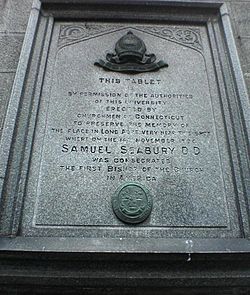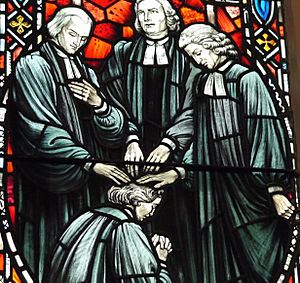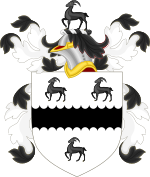Samuel Seabury facts for kids
Quick facts for kids The Most Reverend Samuel Seabury |
|
|---|---|
| 2nd Presiding Bishop of the Episcopal Church | |
 |
|
| Church | Episcopal Church |
| In Office | 1789–1792 |
| Predecessor | William White |
| Successor | Samuel Provoost |
| Other posts | Bishop of Connecticut (1784-1796) Bishop of Rhode Island (1790-1796) |
| Orders | |
| Ordination | December 23, 1753 |
| Consecration | November 14, 1784 by Robert Kilgour |
| Personal details | |
| Born | November 30, 1729 Groton, Connecticut (originally North Groton - now within the town of Ledyard) |
| Died | February 25, 1796 (aged 66) New London, Connecticut, United States |
| Buried | St. James Episcopal Church (New London, Connecticut) |
| Nationality | American |
| Denomination | Anglican |
| Parents | Samuel Seabury & Abigail Mumford |
| Spouse | Mary Hicks |
| Children | 5 |
| Alma mater | Yale College University of Edinburgh |
| Sainthood | |
| Feast day | November 14 |
| Venerated in | Church of England Episcopal Church Anglican Church in North America |
Samuel Seabury (November 30, 1729 – February 25, 1796) was a very important figure in the early history of the Episcopal Church in the United States. He became the first American Episcopal bishop and later served as the second Presiding Bishop of the entire Episcopal Church. He was also the first Bishop of Connecticut. During the American Revolution, he was a strong supporter of the British, known as a Loyalist, and had disagreements with famous figures like Alexander Hamilton.
Contents
Early Life and Education
Samuel Seabury was born in 1729 in a place called North Groton, Connecticut. This area is now part of Ledyard. His childhood home is still standing today as a historic landmark.
His father, also named Samuel Seabury, was first a Congregationalist minister. But in 1730, he became a priest in the Church of England. The Seabury family owned enslaved people, which was common at that time.
Samuel Seabury went to Yale College and graduated in 1748. He then studied theology (the study of religion) with his father. From 1752 to 1753, he also studied medicine in Edinburgh Medical School in Scotland. In December 1753, he was ordained as a deacon and then a priest. After that, he served as a rector (a church leader) in several places in New Jersey and New York.
Samuel Seabury and Slavery
Samuel Seabury grew up in a time when slavery was a part of the economy. His family owned enslaved people. His father's will, for example, mentions an enslaved person named Newport.
When Samuel Seabury married Mary Hicks in 1756, he also became a slaveholder. His father-in-law gave his daughter an enslaved woman as a gift. Later, as part of a legal issue, Samuel Seabury gained ownership of four more enslaved people. After his father-in-law passed away, Seabury kept one enslaved person named Charles.
Records from 1790 show that the Seabury household in New London had three enslaved people. After Bishop Seabury died, a list of his belongings included a 38-year-old woman named Nell and a 9-year-old girl named Rose. His writings show that Nell worked in the church house where he lived.
American Revolution and Alexander Hamilton
During the American Revolution, Samuel Seabury was a strong Loyalist. This meant he supported Great Britain and the King, not the American colonists who wanted independence. In April 1775, he signed the White Plains Protest, which was against the new American congresses and committees.
He wrote several important papers using the pen name "A. W. Farmer" (meaning "a Westchester farmer"). In these writings, he explained why he believed the colonists should remain loyal to Britain. One of his most famous works was "Free Thoughts on the Proceedings of the Continental Congress" (1774).
A young Alexander Hamilton disagreed with Seabury's ideas. Hamilton wrote his own responses, like "A Full Vindication of the Measures of Congress". Seabury wrote back, and Hamilton replied again, leading to a famous debate through written letters.
Seabury's "Farmer's Letters" were known for their clear and direct style. He argued that "liberty is a very good thing, and slavery a very bad thing." He believed that white Loyalists should avoid being treated like slaves, even though he himself owned enslaved people.
In November 1775, American Patriots arrested Seabury. He was held in prison in Connecticut for six weeks. After his release, he found safety in New York City and became a chaplain for a British-supporting military group in 1778. After the war ended, he stayed in the United States and became loyal to the new American government.
Becoming a Bishop

In March 1783, a group of ten Episcopal clergy in Connecticut chose Samuel Seabury to be their bishop. At that time, there were no Anglican bishops in America to officially make him a bishop. So, Seabury sailed to London, England, in July.
However, the English bishops couldn't make him a bishop because he was an American citizen. This meant he couldn't take an oath of loyalty to the British King. So, Seabury looked to the Scottish Episcopal Church. This church was not the official church in Scotland, and its bishops did not recognize the British kings.
Seabury was officially made a bishop in Aberdeen, Scotland, on November 14, 1784. This was a very important moment for the Episcopal Church in America. The Scottish bishops who consecrated him were Robert Kilgour, Arthur Petrie, and John Skinner. The chair used for his consecration is still kept in a church in Keith, Scotland. The day of his consecration is now a special day of remembrance in the Episcopal Church.
Seabury's consecration by the Scottish bishops worried the British government. They were afraid that the American church would become too independent. Because of Seabury's determination, the British Parliament eventually made it possible for foreign bishops to be ordained, which helped keep a connection between the American and English churches.
Church Leadership in America
After becoming a bishop, Seabury returned to Connecticut in 1785 and made New London his home. He became the rector of St James Church there.
In August 1785, the first Anglican ordinations (making people priests or deacons) on American soil happened at Christ Church in Middletown. Bishop Seabury led these services. He said that this church would always be remembered as the "birthplace" of many faithful church leaders.
In 1790, Seabury also became the leader of the Diocese of Rhode Island. In 1792, he joined with other bishops who had been consecrated in England. This brought together the Scottish and English lines of church leadership in the American Episcopal Church.
Changes to Church Services
Samuel Seabury played a big part in shaping how church services were done in the Episcopal Church after the American Revolution. He helped create a special "Communion Office" (part of the church service) that was based on the Scottish way of worship, not just the English one.
He especially pushed for including certain prayers that focused on the Holy Spirit and the idea of offering gifts to God during the service. These changes made the Episcopal Church's worship more similar to older Christian traditions.
Seabury also believed that Holy Communion should be celebrated every Sunday, not just sometimes. In 1789, he wrote that it was important because of "the positive command of Christ" and the "many and great benefits we receive from it." He was ahead of his time, as many churches later adopted weekly communion.
Later Life and Legacy
In 1794, Seabury helped start the Episcopal Academy of Connecticut in Cheshire. This school later became Cheshire Academy.
He passed away in New London on February 25, 1796. His remains are buried in a small chapel at St. James Church there. The church also has a beautiful stained glass window showing his consecration in Scotland.
Samuel Seabury was known as a great organizer and a strong supporter of church traditions. His writings, including the "Farmer's Letters" and his prayers, were widely read and admired for their clear style.

Samuel Seabury was the first bishop consecrated for the Episcopal Church (United States).
Family Life
Samuel Seabury married Mary Hicks in 1756. His brother, David Seabury, was also a Loyalist who moved to Canada but later returned to the United States.
His son, Charles, became a rector in churches on Long Island. His grandson, Samuel Seabury (1801–1872), and great-grandson, William Jones Seabury, also became Episcopal clergymen.
Remembering Samuel Seabury
On September 12, 1849, Samuel Seabury's remains were moved to a special place under the altar at St. James the Great in New London. This was a very solemn ceremony. People who saw his remains noted that his skeleton was well-preserved and his head was unusually large.
Samuel Seabury is remembered and honored on November 14 in the calendars of the Church of England, the Episcopal Church, and other Anglican churches. This day marks the anniversary of his consecration as a bishop.
Several groups and societies have been named after Bishop Seabury to honor his memory and contributions to the church.
Honors and Namesakes
Many places and institutions are named after Samuel Seabury to honor his important role in the Episcopal Church:
- Seabury Hall at Trinity College in Hartford, Connecticut.
- Seabury-Western Theological Seminary, a seminary for training church leaders.
- Bishop Seabury Academy in Lawrence, Kansas, and Seabury Hall in Makawao, Hawaii, which are private schools connected to the Episcopal Church.
- Bishop Seabury Anglican Church in Connecticut, founded in 1875.
See also
- List of presiding bishops of the Episcopal Church in the United States of America
- List of Episcopal bishops of the United States
- Historical list of the Episcopal bishops of the United States
- William Jones Seabury



